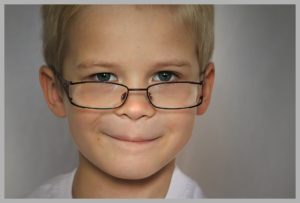It’s estimated that one out of four children struggle with reading and learning because of undiagnosed vision problems. Many of the signs, symptoms, and behaviors that are caused by vision problems are also associated with learning disabilities, so some of these children are misdiagnosed as having a learning disability.
Since 80% of what children learn comes through visual processing of information, children with undiagnosed vision problems have a serious disadvantage academically, as well as emotionally and socially. However, parents and teachers often don’t suspect vision problems because the child passed the school vision screening.
Vision screenings in school and at a pediatrician’s office typically test only distance vision with an eye chart. Children who score 20/20 with an eye chart may be told they have “perfect vision,” when in fact 20/20 is simply a measurement of what they are able to see at a distance of 20 feet. Most learning, however, is done at a close up reading distance, which isn’t usually tested in most vision screenings and routine eye exams.
It’s not just the ability to see the blackboard or read a book close up, either. There are actually 17 visual skills required for reading and learning, including eye coordination, eye tracking, visual form perception, visual memory, and visual-motor integration.
Children usually aren’t able to identify that they have a vision problem, and adults can mistake their behavior or symptoms as a learning disability. But when children struggle with visual tasks, they may not recognize that the problem is with their eyes. All they know is that they’re having a harder time with daily tasks than their classmates, which can be confusing and upsetting.
Some symptoms of a vision problem are easier to observe, such as frequent squinting, but others are more subtle. When specific visual skills are poorly developed, learning is difficult and children will typically:
- Avoid reading and other close-up visual work as much as possible.
- Attempt to do the work, but with less comprehension or efficiency than their peers.
- Experience discomfort, fatigue, and a short attention span.
- Be easily distracted, ranging from seeming lazy or hyperactive.
When To Have An Eye Exam
Children should receive an eye examination every year, or more frequently if recommended by an eye doctor. Even if a child passes an eye-chart vision screening, they should receive a comprehensive optometric examination, especially if they are struggling in school or seem easily distracted and frustrated by schoolwork.
The earlier a vision problem is detected and treated, the more likely treatment will be successful. When needed, an optometrist can prescribe glasses, contact lenses, or vision therapy to correct childhood vision problems.
In order to give our children every advantage to succeed in and outside of school, it’s important to make sure that if they do have a vision problem, it gets diagnosed and treated as soon as possible.
At Hardin Valley Eyecare & Optical in Knoxville, we are dedicated to helping children have the best vision possible so that they don’t have to struggle with daily tasks. Our eye care professionals are dedicated to providing exceptional personal service to each person who walks through our door. If you want to schedule an eye exam for your child, call us at (865) 246-1500 or contact us today to schedule your appointment.





